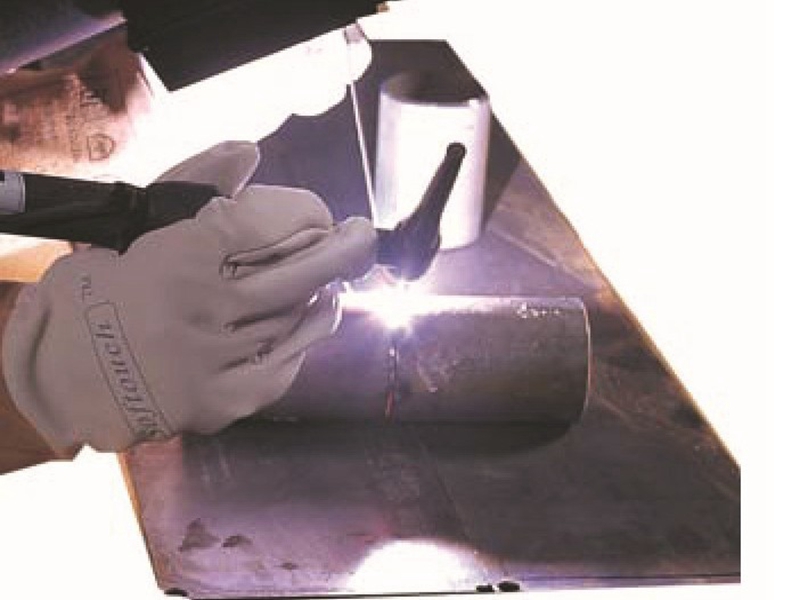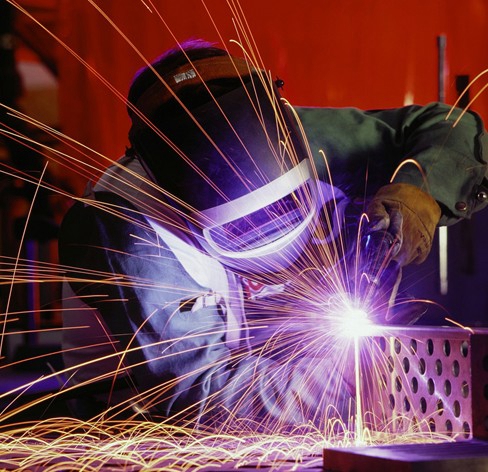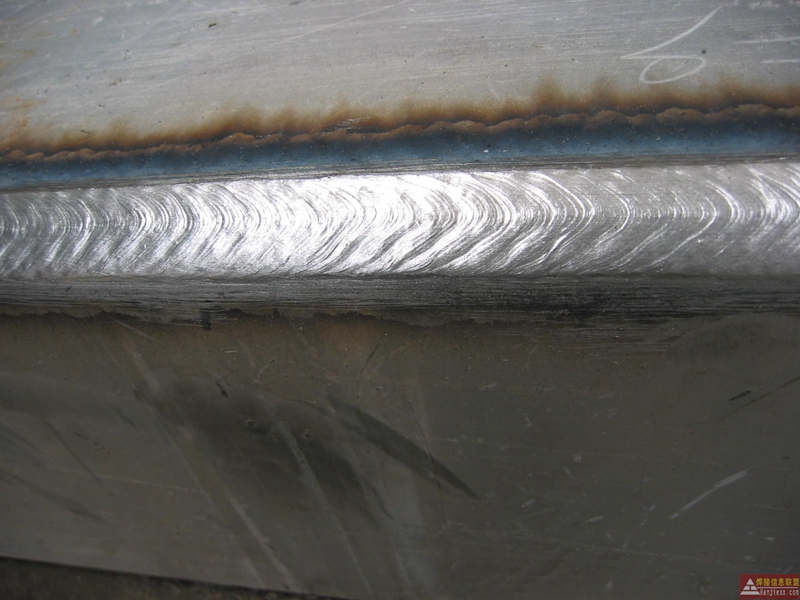Argon arc welding is a welding technique that uses argon as a shielding gas. Also known as argon gas shielded welding. That is, an argon gas is applied around the arc welding to isolate the air from the weld zone to prevent oxidation of the weld zone.
The argon arc welding technology is based on the principle of ordinary arc welding, using argon gas to protect the metal welding material, and melting the welding material on the material to be welded into a liquid to form a molten pool by high current, so that the metal to be welded and the welding A welding technology that achieves metallurgical bonding. Since argon gas is continuously supplied in high-temperature fusion welding, the welding material cannot be in contact with oxygen in the air, thereby preventing oxidation of the welding material, so that stainless steel and iron metal metal can be welded. .
Classification
1, non-melting pole
Working principle and characteristics: Non-melting argon arc welding is the arc burning between the non-melting pole (usually tungsten) and the workpiece, and an inert gas that does not chemically react with the metal flows around the welding arc (usually argon gas) ), forming a protective hood so that the tungsten extremes, the arc and the molten pool and the high temperature metal adjacent to the heat affected zone are not in contact with the air, preventing oxidation and absorption of harmful gases. Thereby forming a dense welded joint, the mechanical properties are very good.
2, the melting pole
Working principle and characteristics: The welding wire is fed through the wire wheel, the conductive nozzle is conductive, an electric arc is generated between the base metal and the welding wire, the welding wire and the base material are melted, and the arc and the molten metal are protected by an inert gas argon gas for welding. It differs from tungsten argon arc welding: one is the wire as the electrode, and is continuously melted and filled into the molten pool to form a weld after condensation; the other is to use a protective gas, which is protected with the technical application of argon arc welding. Gas has been developed from a single argon gas to a wide range of mixed gas applications, such as argon or helium as a protective gas called molten inert gas shielded arc welding (referred to as MIG welding in the international); When the mixed gas of oxidizing gas (O2, CO2) is a protective gas, or when the mixed gas of CO2 gas or CO2 + O2 is used as a shielding gas, it is collectively referred to as a molten gas active gas arc welding (referred to as MAG welding in the international market). From the perspective of its operation mode, the most widely used ones are semi-automatic argon-shielded arc welding and argon-rich gas mixture welding, followed by automatic argon-shielded arc welding.

Working Principle
The working principle of argon arc welding in the main circuit, auxiliary power supply, drive circuit, protection circuit, etc. is the same as hand arc welding. It will not be described here, but the control functions and arc-starting circuit functions unique to the argon arc welding machine will be emphasized.
Characteristics
1, high effect
The current density is large, the heat is concentrated, the deposition rate is high, and the welding speed is fast. In addition, it is easy to lead the arc. Argon arc welding needs to be strengthened. Because the arc is strong and the smoke is large, it is necessary to strengthen the protection.
2, protective gas
The most common inert gas is argon. It is a colorless, odorless gas having an air content of 0.935% by volume and argon having a boiling point of -186 ° C between the oxygen and the boiling point of hydrazine. Argon is a by-product of the oxygen plant's fractionation of liquid air to produce oxygen.
China uses bottled argon for welding, and its filling pressure is 15 MPa at room temperature. The cylinder is painted in grey and marked with the word "argon". The chemical composition requirements of pure argon are: Ar≥99.99%; He≤0.01%; O2≤0.0015%;H2≤0.0005%; total carbon amount≤0.001%; moisture≤30mg/m.
Argon gas is an ideal protective gas, which is 25% larger than air density. It is beneficial to protect the welding arc during flat welding and reduce the consumption of shielding gas. Argon is a chemically inactive gas that does not chemically react with metals even at high temperatures, thus eliminating the oxidative burning of alloying elements and the resulting problems. Argon is also insoluble in liquid metal and therefore does not cause pores. Argon is a monoatomic gas that exists in an atomic state and has no molecular decomposition or atomic absorption at high temperatures. The specific heat capacity and heat conduction capacity of argon gas are small, that is, the absorption amount is small, the heat transfer is small, the heat in the arc is not easily lost, the welding arc is stable in combustion, and the heat is concentrated, which is favorable for welding.
The disadvantage of argon is that the ionization potential is higher. When the arc space is filled with argon, the ignition of the arc is more difficult, but the arc is very stable once it is ignited.

Advantages
The reason why argon arc welding can obtain such a wide range of applications is mainly because of the following advantages.
1. Argon gas protection can isolate the adverse effects of oxygen, nitrogen and hydrogen in the air on the arc and the molten pool, and reduce the burning loss of the alloying elements to obtain a dense, spatter-free, high-quality welded joint;
2. The arc burning of argon arc welding is stable, the heat is concentrated, the temperature of the arc column is high, the welding production efficiency is high, the heat affected zone is narrow, and the stress, deformation and crack tendency of the welded weldment are small;
3. Argon arc welding is applied to open arc welding, which is convenient for operation and observation;
4. The electrode loss is small, the arc length is easy to maintain, and there is no flux or coating layer during welding, so it is easy to realize mechanization and automation;
5, argon arc welding can weld almost all metals, especially some refractory metals, easily oxidized metals, such as magnesium, titanium, molybdenum, zirconium, aluminum and other alloys;
6. All positions can be welded without being restricted by the position of the weldment.
Disadvantages
(1) Because of the large heat affected zone, the argon arc welding often causes deformation, hardness reduction, blisters, local annealing, cracking, pinholes, abrasion, scratching, undercutting, or insufficient bonding force and internal stress after repairing. Shortcomings such as damage. Especially in the repair process of fine defects of precision casting parts, the surface is prominent. In the field of repairing precision casting defects, a cold welder can be used instead of argon arc welding. Because of the low heat release of the cold welder, the shortcomings of argon arc welding are better overcome, and the repair problem of precision castings is compensated.
(2) Compared with electrode arc welding, argon arc welding has a higher degree of damage to the human body. The current density of argon arc welding is large, and the light emitted is relatively strong. The ultraviolet radiation generated by its arc is about ordinary electrode arc welding. 5~30 times, the infrared ray is about 1~1.5 times of the electrode arc welding, and the ozone content generated during welding is high. Therefore, try to choose a place with good air circulation, otherwise it will cause great harm to the body.
(3) For low melting point and easily vaporized metals (such as lead, tin, zinc), welding is difficult.
Process
(1) Welding example The economizer, the evaporative section tube bundle, the water wall and the low temperature superheater are made of No. 20 steel, and the high temperature superheater tube is 12Cr1MoV.
(2) Preparation before welding Before welding, the nozzle should be made with a 30° groove, and the inner color of the tube should be ground within 15mm. The gap between the pipes is 1~3mm. When the actual gap is too large, the transition layer must be welded on the side of the pipe. Establish temporary shelters and strictly control the wind speed at the welding operation. Because the wind speed exceeds a certain range, it is easy to produce pores.
(3) Operation Using the WST315 manual tungsten argon arc welding machine, the welding machine itself is equipped with a high-frequency arc-ignition device, which can adopt high-frequency arc ignition. The arc extinction is different from the arc welding of the electrode. If the arc is too fast, the arc crack is easy to occur. Therefore, the molten pool should be led to the edge or the base material is thicker, and then the molten pool is gradually reduced and the arc is gradually extinguished. Protective gas.
For the 20th steel pipe with a wall thickness of 3~4mm, the filling material can be TIGJ50 (for 12Cr1 MoV, available 08CrMoV), tungsten rod diameter 2mm, welding current 75~100A, arc voltage 12~14V, protective gas flow 8~10L/ Min, the power supply type is DC positive connection.

Application of argon arc welding:
Argon arc welding is suitable for welding non-ferrous metals and alloy steels (mainly welded with Al, Mg, Ti and their alloys and stainless steel); suitable for single-sided welding double-sided forming, such as bottom welding and pipe welding; tungsten Argon arc welding is also suitable for thin plate welding.
Security
(1) Ventilation measures The argon arc welding work site should have good ventilation to discharge harmful gases and smoke. In addition to the ventilation of the plant, several axial fans can be installed to vent the outside air where the welding workload is large and the welding machine is concentrated.
In addition, local ventilation measures can be used to remove harmful gases around the arc, such as an open arc exhaust hood, a smoke extraction torch, and a light portable fan.
(2) Shielding measures Measure the use of strontium tungsten poles with extremely low radiation dose. For the processing of tantalum tungsten and tantalum tungsten, seal or drafting wheel grinding should be used. Operators should wear personal protective equipment such as masks and gloves. Wash hands and face after processing. The tantalum tungsten and tantalum tungsten should be stored in an aluminum box.
(3) Measures to protect high frequency.
In order to guard against and weaken the effects of high frequency electromagnetic fields, the measures taken are:
1) The workpiece is well grounded, and the torch cable and ground wire are shielded with metal braided wires;
2) Properly reduce the frequency;
3) Try not to use the high-frequency oscillator as a stabilizing device to reduce the high-frequency electric action time.
(4) Other personal protective measures
In argon arc welding, due to the strong action of ozone and ultraviolet light, it is advisable to wear non-cotton overalls (such as acid-resistant, silk, etc.). In the case of welding in the container and local ventilation is not allowed, personal protective measures such as air supply helmets, air hoods or respirator can be used.

